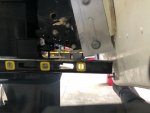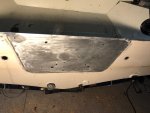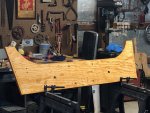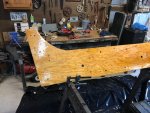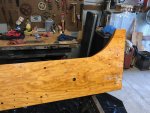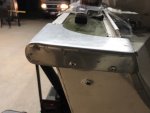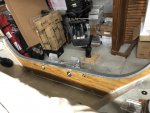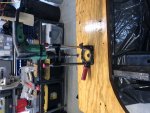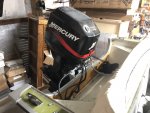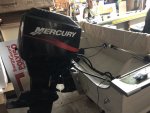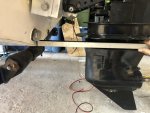Update a short questions. Classiccat, did you add filler just for the holes? And did you chamfer after drilling the epoxy, or before filling the holes?
You want to chamfer the
oversized holes before adding filler. If for whatever reason the epoxy lost adhesion, it would remain locked in place (that's never happened to me).
Here's a diagram I drew for 1 side chamfered. I actually chamfer both.
Once you drill it, put tape on the "beauty side" to minimize the amount of sanding you have to do...there are examples of this in my recent posts in my rebuild thread.
Add the epoxy/silica mixture to a baggie, cut the tip off and squeeze into the hole.
Once cured, then you can drill your holes.
I have a few unused holes in the back aluminum transom enclosure (bad terminology). I have some fluxless aluminum brazing rods and map torch. I was thinking of tackling those from the inside where the raw aluminum is, rather that more silicone plugs as it was when I got it. Is this advisable?
If they're single holes, most of us use solid rivets coated with 5200.
In a pinch you can use a stainless steel nut/bolt coated with 5200 and nylon washers front/back.
I personally like solid rivets b/c the aluminum fills the hole and you don't have to worry about any galvanic reaction.
another option is aluminum closed-end blind rivets coated with 5200.
We ripped the 3/4" ply lengthwise and cut 2ft off the end. Perfect size for one transom sadwhich. I used half a quart of 5:1 epoxy, spread with a 5" putty knife, to glue the two sheets together. I hope that was enough. It seemed like a nice wet coat, but only a little squished out from the edges. I screwed it together with ss woodscrews after predrilling through the top sheet so as to pull it tight against the bottom one. I mimicked your screw pattern, though it doesn't look quite as polished as yours. It's been almost 24 hours, and I'll cut the transom out tomorrow. I traced the transom first before gluing so I could mark my wood screw holes in locations that wouldn't interfere with the cut and mounting holes later.
that should be pretty solid! did you add any filler to the epoxy? Colloidal silica is popular when bonding.
I was planning on putting the screw side facing the aluminum part of the transom so the screws will be hidden. Do you see this causing any issues, or should I put the screwed side facing the bow to avoid any metal/metal contact between screw heads and aluminum?
It won't matter if you're adding glass cloth... since it will serve as a barrier.
you may want to make a map/template of where you put those screws in case you add something down the road (swim ladder, smart tabs, etc.)
Finally, I removed some rotten flooring from the back corners which gave me a better view of whats going on back there. Some pesky water kept creeping in to my photos. Here is what the knee brace and back rivets look like. The bilge area looks nastier than it is because of the brackish water that has apparently been sitting there for a few weeks. It did not look like that when I first bought the boat.
That knee brace looks good! I'm really surprised considering how much that old transom was flexing on ya.
+1 on what Watermann said...you'll really want to clean up that transom skin corrosion and its much much easier with the splashwell removed.
the rest of the aluminum in the bottom hull skin looks pretty good...even through the muck...no obvious signs of serious corrosion there.
























